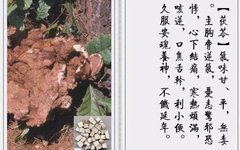
In the “Huainanzi: Shuo Shan Xun”, it is recorded: “The thousand-year-old pine has Poria (Fuling) below and rabbit (Tu) silk above.” When it comes to Poria, everyone is certainly familiar with it. As a medicinal and edible material that promotes diuresis and drains dampness, it is particularly favored in the southern regions of China during the long rainy season. People incorporate Poria into tea, soups, pastries, and dishes, and the methods of consuming Poria are countless. In soups, Poria is often added to help the body promote diuresis and expel dampness.
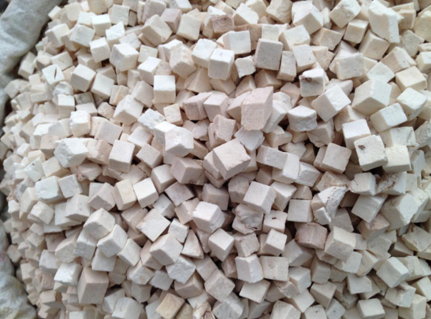
As a common medicinal and edible ingredient native to China, Poria has a long historical presence. It was referred to by ancient people as the “divine medicine of all seasons” (effective regardless of season and compatible with various medicines, it can exert its unique effects on all ailments of cold, heat, wind, and dampness) and is honored with the titles “Ten Directions Nine Ling” and “Medicinal Cuisine Baiyin”.
Poria was first recorded in the medical classic “Shennong Bencao Jing”, which states: “Poria, sweet and neutral, also known as Futu, grows in the valleys of Mount Tai.” In the Ming Dynasty, Li Shizhen’s “Bencao Gangmu” described Poria as “having a light and penetrating flavor, its nature ascends, generates body fluids, opens pores, nourishes the water source and descends, and facilitates urination. The “Pharmaceutical Chemical Meaning” describes white Poria as “having a uniquely sweet and light flavor; sweetness can tonify, lightness can drain; sweet and light belong to the earth, used to tonify the spleen yin, earth is strong and generates metal, also benefits lung qi,” particularly highlighting the specific pharmacological rules of white Poria.
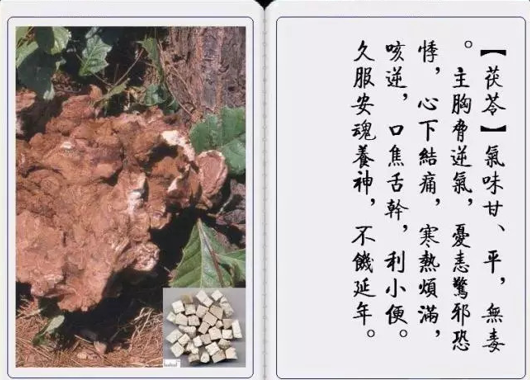
The “Shennong Bencao Jing” records
Based on the historical records above, and through clinical experience and the test of time, the “Chinese Pharmacopoeia” summarizes it as sweet, light, and neutral. It belongs to the heart, lung, spleen, and kidney meridians. It has the effects of promoting diuresis and draining dampness, strengthening the spleen, and calming the heart. It is used for edema, reduced urination, phlegm, dizziness, spleen deficiency with reduced appetite, loose stools, anxiety, and insomnia【1】.
Poria mainly contains polysaccharides: β-Poria polysaccharides, triterpenoid components: Poria acid, Poria lactone, Poria acid, and tooth hole acid; sterol components: ergosterol, etc.; it also contains proteins, fats, lecithin, adenine, etc. It has effects of regulating immunity, diuresis, anti-tumor, and antibacterial properties【2】.
The “Chinese Pharmacopoeia” records Poria as the dried sclerotium of the fungus Poria cocos (Schw.) Wolf, mainly produced in Anhui, Yunnan, and Hubei. It is divided into cultivated and wild types, with cultivated ones having a larger yield, especially in Anhui, known as “Anling”; Hubei also has a large yield; wild ones are mainly from Yunnan, also known as “Yunling”, with “Yunling” being of superior quality. It mainly parasitizes the roots of Pinus massoniana and Pinus tabulaeformis. It is harvested from July to September, and its specifications are:
“Poria pieces”: After excavation, remove the mud and sand, pile them for “sweating”, then spread out to dry until the surface is dry, and then “sweat” again, repeating several times until wrinkles appear and most of the internal moisture is lost, then dry in the shade.
“Poria skin”: When slightly dry and the surface is wrinkled, the outer skin is peeled off.
“Poria slices”: The central part of fresh Poria, after peeling, is sliced and dried in the shade.
“Poria chunks”: The central part of fresh Poria, after peeling, is cut into chunks and dried in the shade.
“Red Poria”: Pieces cut from the brownish-red or light red parts.
“White Poria”: The white parts cut from “Red Poria” or pieces cut from the white parts.
“Fushen”: Poria sclerotium naturally containing pine roots during growth.
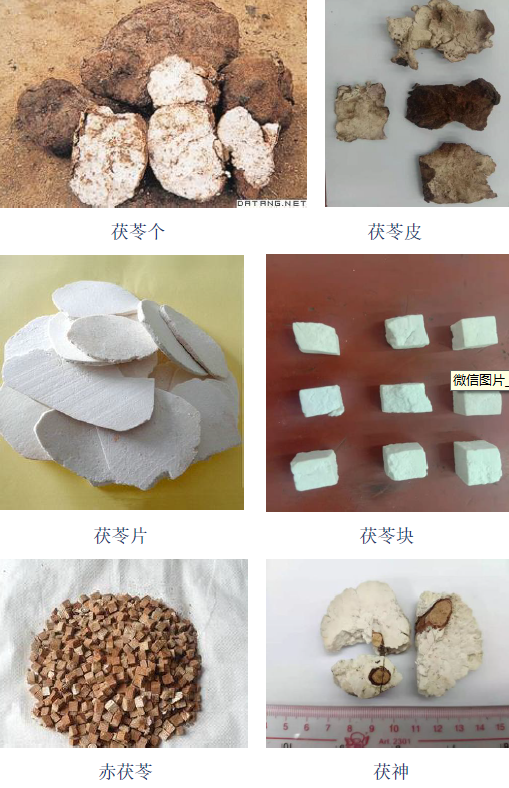
How to select high-quality authentic Poria?
As long as you grasp the following important information, you can purchase with confidence.
Authentic Poria: Quality is determined by weight, solid texture, fine white and delicate cut surface, and strong stickiness.
1. Shape characteristics: Blocky or flaky
2. Color: White or slightly light red
3. Cross-section: Rough, granular
4. Texture: Solid, not easily crushed when rubbed by hand
5. Smell: Odorless, light taste
6. Taste: Chewy and sticky
7. Color reaction: Drops of iodine solution (iodine tincture) show yellow
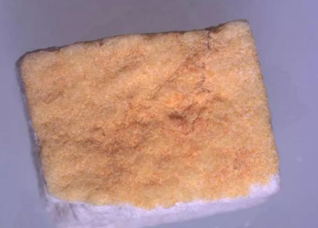
What counterfeit products are currently sold in the market or by unscrupulous vendors?
1. Made from starch or yam powder: Its characteristics include a uniform surface color, or all pure white, light weight, loose texture, easily turning into coarse powder when rubbed, slightly sweet taste, and not sticky when chewed. Drops of iodine solution (iodine tincture) show blue.
2. Made from corn: Surface is white or light yellow, cross-section is powdery, light weight, loose and easily broken, sweet taste, and sticky when chewed. Drops of iodine solution (iodine tincture) show blue-purple.
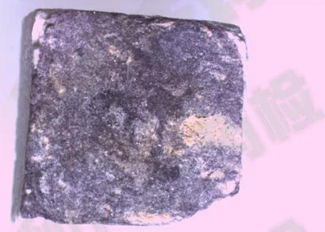
※Medicinal Tea※Poria Lotus Root Tea
Ingredients: Fresh lotus root 120g, Poria 12g, Chinese yam 12g, lily 10g, 10 dates
Effects: Nourishes lung yin, tonifies spleen qi.
Preparation: First wash and slice the fresh lotus root, then boil to extract the juice, to the desired concentration.
Precautions: This tea should not be consumed cold.
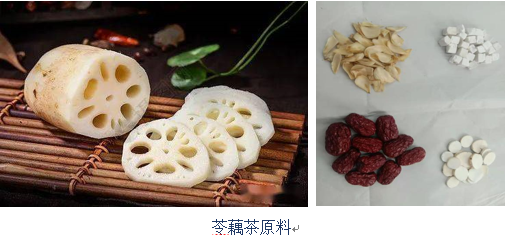
※Medicinal Tea※Poria Tea
Ingredients: Green tea 1-2g, Poria 5-10g, honey 25g
Effects: Used for general edema.
Preparation: Grind Poria into powder, add 500ml of water, boil while stirring, and after boiling, add green tea and honey.
Dosage: Once daily.
*Medicinal Cuisine* Poria Buns
Ingredients: Poria 50g, flour 1000g, fresh pork 500g, ginger 15g, pepper 5g, sesame oil 10g, Shaoxing wine 10g, salt 15g, soy sauce 100g, green onion 25g, bone broth 250g.
Effects: This recipe of Poria strengthens the spleen, calms the heart, and promotes diuresis and drains dampness. It is beneficial for patients with spleen deficiency and excess dampness presenting with abdominal distension, reduced appetite, loose stools, difficulty urinating, or palpitations and insomnia.
Preparation:
① Remove the skin from Poria (preferably using white Poria), soak in water, steam until soft and slice (or directly purchase Poria slices to steam until soft), boil to extract the juice, adding about 400ml of water each time, heating and boiling for three times, each time for 1 hour, combine the three medicinal juices, filter, and concentrate to 500ml for use.
② Pour flour onto the board, add 300g of leavened dough, and warm Poria water 500ml to form a dough for fermentation.
③ Mince the pork, place in a bowl, add soy sauce and mix well, then add minced ginger, salt, sesame oil, Shaoxing wine, chopped green onion, pepper, and bone broth to mix the filling.
④ Once the dough has risen, add an appropriate amount of alkaline water, knead well, test the acidity and alkalinity of the dough (not yellow or sour), then roll into long strips of 3-4cm, divide into 20 pieces, flatten each piece into a round skin, fill with the filling, and wrap into raw buns.
⑤ Place the wrapped raw buns in a steamer, steam over boiling water for about 15 minutes until done.
As a medicinal and edible food, Poria leans more towards medicinal properties, and all Chinese medicines have certain tendencies. If used according to the syndrome, it is beneficial; if not, improper use can have side effects. Due to its diuretic and damp-draining effects, it is effective for edema and fullness caused by water retention, diarrhea due to spleen deficiency unable to transform water and dampness, and palpitations and insomnia caused by phlegm disturbing the heart. However, for those with qi deficiency and sinking, internal heat and thirst, presenting with dry mouth and throat, red tongue with little fluid, taking Poria would be harmful rather than beneficial; the pathogenesis is already yin deficiency with little fluid, and further draining water and dampness would only worsen the condition. It is also not suitable for those with kidney deficiency, as their condition already involves frequent urination and water retention, and taking Poria would lead to excessive urination, potentially causing greater harm to the kidneys. It is recommended that those with the above symptoms avoid taking Poria and other diuretic and damp-draining medicines.
References
[1] National Pharmacopoeia Commission. Pharmacopoeia of the People’s Republic of China (2020 Edition, Volume 1) [S]. Beijing: China Medical Science Press, 2020:251.
[2] Clinical Use of Chinese Medicine in the Pharmacopoeia of China. National Pharmacopoeia Commission. Clinical Use of Chinese Medicine in the Pharmacopoeia of the People’s Republic of China (2015 Edition)·Chinese Herbal Pieces Volume [M]. Beijing: China Medical Science Press, 2017:499-500.
 END
END
Source: Beijing Association of Traditional Chinese Medicine, Committee of Chinese Medicine Resources and Identification
Author: Li Baoyin, Xuanwu Hospital, Capital Medical University
Review: Liu Chunsheng, Chairman of the Committee of Chinese Medicine Resources and Identification, Beijing Association of Traditional Chinese Medicine
Editor: Chen Yixuan
Review: Han Weiwei Supervisor: Yang Na
We welcome your submissions, please send to [email protected]

